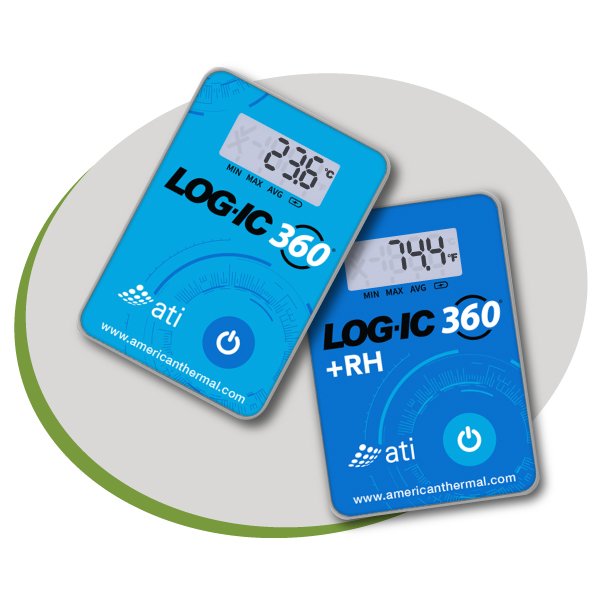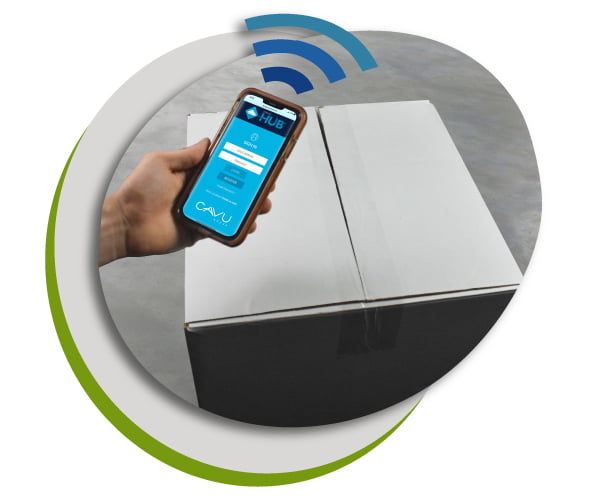The Ultimate Guide to Data Loggers
How Data Loggers Record Temperature
And Why You Should Care
Data loggers used for targeted temperature management record temperature using two different technology options. First is the thermistor, which is a resistor that changes resistance based on temperature and has been around for many years. They’re relatively reliable and have a wide range of practical uses, basing their accuracy on a 3-point calibration.
Other temperature management solutions are digital in nature, powered by an internal sensor packaged in a microchip. These come factory-calibrated to measure average temperature, temperature range, and temperature history with extreme accuracy. This sophistication allows a supply chain to capture critical temperature data with mobile devices in industries like Medical Device, Life Sciences, and Food.
For industries like medical devices, pharmaceutical supply chains, and cold chain logistics, fully validated products are a requirement. Without target temperature management in place, patient safety can become at risk, especially when you’re shipping temperature-sensitive vaccines or medical devices like heart monitors.
Premium digital NIST traceable sensors provide certification through more than just a 3-point calibration, guaranteeing accuracy across the entire sensing range. It relates back to the use of the Steinhart–Hart equation. The 3 identified points are used to calculate the A,B,C coefficients. Unlike the mechanical limitations of a data logger utilizing a standard thermistor, ATI’s LOG-IC 360 BT technology delivers guaranteed accuracy plus or minus a quarter degree.

What You Need to Know About Mean Kinetic Temperature
MKT, or mean kinetic temperature, is the simplified way of expressing the overall effect of temperature fluctuations during the storage or transit of perishable goods. That’s the simple explanation – it’s actually a highly complex equation that factors on the activation energy of the products to yield a simplified equivalent of temperature exposure. Why is this important?
Here is an example:
A dozen eggs sat in a 20º C room for 2 hours
In 2º C refrigeration for 4 hours
And on a 25º C loading dock for 1 hour
Using MKT we can calculate that the temperature profile of the eggs was “thermally equivalent” to storing them at 15.7º C for 7 hours.
In order to maintain the quality within the Pharmaceutical Industry, the FDA has approved MKT as a standard based on a number of various proposals, discussions, and decades of efforts to identify product degradation. MKT takes into consideration temperature velocities (rates of change) based on the product and its exposure to various temperatures. MKT also factors time and thermal mass into the equation. It’s a critically important and often underutilized factor based on industry. Not all data loggers actually display MKT which can provide inaccurate information about a shipment. An increase in loss products based on a lack of captured data means a loss of confidence and revenue for your brand.
How Data Loggers Safeguard the Pharmaceutical Supply Chain
Data loggers work hand in hand with chemical indicators to bring invaluable insight and brand protection to your supply chain. These electronic or Bluetooth data loggers are typically used for target temperature management for large packages and pallets, whereas chemical indicators might be used at the individual unit level within the pallet.

This is especially important to monitor what’s called “the last mile,” or the final segment of the supply chain. This is where an item is being delivered to the end-user and average temperature is most susceptible to fluctuations. Often, companies rely on an internal sensor to monitor packages during shipping, but overlook temperature management during the last mile. As a result, the last mile is most shipments lose their integrity when it comes to temperature and humidity exposure.

Why Instant Insight is Critical
Data loggers, just like any other technology, have witnessed tremendous strides over the years in accessibility and sophistication. In the past, you’d have to pull the temperature data loggers out of the boxes, transfer the information to long reels of printed paper, and then communicate it to the relevant parties by telephone or mail.
Now, with advances in technology, we’re able to use Bluetooth and mobile devices to pull the data without opening the pallets. We can then upload the temperature readings instantly to the cloud where remote teams of Cold Chain Logistics and Temperature Management professionals all over the world can review the information. This kind of instant access allows companies to be more proactive with their Targeted Temperature Management strategies and reduce costs in significant ways.
For example, let’s imagine that a shipment is en route from California to New York and hits a checkpoint in Iowa. The temperature data logger gets read and reveals that somewhere along the route, the shipment fell out of the required temperature range. With this insight, the temperature management teams are able to stop the shipment right there instead of spending the money it would take to continue moving it all the way to New York. A huge cost-saving opportunity!
Temperature management also allows companies to prove compliance with FDA regulations. If rules require that certain drugs need to be kept within a specific temperature range, data loggers give them the ability to prove that a shipment was never exposed to temperatures outside of that range for the entire length of the supply chain.
How Efficient is Your Supply Chain?
The more touch points that are in your supply chain, the more opportunities for a loss in efficiency because each of those introduces the possibility of human error, downtime, and exposure to extreme temperatures.
It’s every logistics manager’s nightmare to have one of their shipments sitting in a distribution center somewhere with no visibility to what’s going on. How long has it been there? When did it arrive? Is it being kept at the proper temperature range? Is there moisture? When will it go to its next destination?
Downtime like this can be absolutely disastrous for on-time deliveries, one of the most important metrics for the efficiency of a supply chain. More than that, it’s more cost-effective to have shipments arrive quickly and on time. When the product isn’t delivered to the end-user, you’re not making money on it.
Far too often, people are waiting for an email or for someone to check a product that was already checked six hours ago, but nobody knew that that was done because the data is not shared throughout the supply chain. There’s a ton of that in the supply chain that can be efficiently eliminated if data is shared.
When that data isn’t shared and the supply chain isn’t optimizing at or near-optimal levels of efficiency, you’re going to run into quality problems that could hurt your brand reputation, and maybe even run into costly compliance issues.
%
of small businesses don’t track their inventory
How Does Connectivity Assist in Supply Chain Risk Management?
There are many benefits of adding connectivity to your supply chain, but two that instantly become important for any business are visibility and traceability. That comes from having instant availability to data, which is connecting the dots between suppliers, manufacturers, logistics organizations, and all key stakeholders.
That type of connectivity allows Category Managers the ability to have an overarching view into customer safety, product integrity, product availability, and brand protection. From a brand perspective, it gives transparency to everyone involved that the product has been supported, managed, developed, designed, produced, and distributed correctly.
In a data-driven world, we manage by exception. When shipments arrive on time and when products work the way they’re supposed to, there’s no corrective action needed. It’s when things go poorly – AKA the exception – that we need to step in and make adjustments.
Just like with many other things, if you have to constantly oversee every little detail and micromanage, you don’t get anything done. However, if you can manage just the data that is of concern, then you have the opportunity and the freedom to be much more productive and proactive.
%
of companies report full visibility on their supply chain
This model allows Category Managers to focus their time and energy on more profitable endeavors, like enhancing their processes or developing new products. It’s also critical to have as few incidents as possible because brand integrity is on the line.
That’s why connectivity goes hand-in-hand with supply chain risk management.
If you have statistics around the performance of your supply chain through trend analysis, you can identify and anticipate where your vulnerabilities are. When your job is to make sure that your customers get the right product at the right time, that it’s packaged and priced correctly, and performs as expected, this type of insight is invaluable.
That level of visibility into your supply chain will also give you real-time, data-driven insights. That’s actionable data that allows you to hone in on opportunities to streamline your supply chain, reduce inefficiencies, and increase profitability. If everything is going well and predictable, and you have confidence in your supply chain, you can turn your attention to growing the business instead of spending your time putting out fires.
How Data Loggers Connect the Pharmaceutical Supply Chain
Did you know that temperature has affected the healthcare industry for over 170 years? U.S. Physician, John Gorrie, built a refrigerator in 1844 to produce ice for cooling the air for yellow fever patients. According to the Medicines and Healthcare Products Regulatory, almost one third of all critical and major deficiencies uncovered in the storage and transportation of medicines relate to the control and monitoring of temperature.
With the rising complexity of development around personalized medications and biologics, temperature becomes even more critical. While there used to be a heavy focus on the 2°C to 8°C temperature range, the uniqueness of pharmaceuticals now ranges from cryogenic, frozen, chilled, to various controlled room temperatures (CRT’s) up to 40°C. With this wide range comes the need for customized time and temperature solutions than can monitor the product from manufacturing to delivery. The easy answer is data loggers!
Data loggers connect the Pharmaceutical Supply chain by providing digital data that can easily be used for tracking, analytics, trend analysis, and even the auditing process. Having digital temperature data at your fingertips for each temperature-sensitive pharmaceutical product is extremely powerful. There are never any questions as to what temperature and for what length of time each shipment was exposed to.
Even further, storing data in a centralized database not only ensures compliance but provides incredible insight to performance improvements in each distribution channel, shipping partner and packaging choice.
Data is imperative when shipping temperature-sensitive pharmaceutical products and the technology behind electronic data loggers is making it easier to connect key stakeholders within the Pharmaceutical Supply Chain.
Tools and Tips for Protecting Your Brand Integrity
We have found that thermal management and temperature monitoring go hand-and-hand. If a temperature-sensitive product is being kept at temperature by use of ice packs, heat packs, PCM’s (phase change materials) or a validated shipper, the manufacturer of that product must be mandated or ultimately concerned of the potential temperature-risk that could affect the quality.
While ice and heat packs are commonly used, advanced forms of PCM (phase change materials) products could be the ideal solution for your brand. From our experience, PCMs maintain a set temperature longer, provide a wider range of temperature options and do not sweat.
It’s ideal to protect your shipment on all levels. For instance, if you are shipping 10,000 vaccines in a box, that is then palletized and placed on a truck, tracking temperature on product, at the box level, and at the pallet and truck level could save you money! Product quality could be affected within certain boxes but not others. Nonetheless, quality could be affected within a certain section of the box (for example the outer edge) but not the center of the box. This allows for individualized sorting to ensure the product quality isn’t affected.
While data loggers are very powerful, some must be manually handled through NFC readers or USB ports to gather the data. Bluetooth technology allows you to pull the temperature data of a box or shipment without ever opening the box. Integrated systems could pull the data as soon as they enter a specific area of a warehouse or shipping yard. The manual efforts lessen or may completely go away!
Temperature monitoring is a wide statement. There are a number of devices available from indicators that turn color to electronic indicators, data loggers, and real-time devices. It’s ideal to map out the temperatures that could affect the quality of your product and back-in to a device or devices that fit your process. Indicators that turn color could be perfect at the product level but paired with an electronic data logger at the box level, gives valuable insight into your shipping lanes.
Finding a supplier of electronic solutions that also provides a platform to collect, store and analyze your data is ideal. This allows for ease of sharing and the ability to predict shipping temperatures in the future, protecting your brand from possible threats.
Validated products are a must for many industries. Having a supplier that is able to provide the necessary documentation to ensure the product is in a specific working condition is crucial. You will not question if your product and ultimately your brand is protected.
Wireless data Loggers Vs. Manual Temperature Tracking

Meeting Regulations Isn’t Enough
Many companies have identified ways to track and store temperature data in order to meet regulatory needs. Some are kept via manual record, whereas others are more sophisticated by keeping their data within their Quality Management System (QMS).
While these solutions may get the job done, data can be collected without any manual effort using a wireless Bluetooth logger. Through the use
of an app on any smart device, data can easily be pulled without ever opening a box or shipment.
With the right supplier, supported cloud solutions can capture the data from there and make it available to any authorized user. This process is done with very little manual effort.
What is a data logger and how is it different from other electronic solutions?
A data logger is an electronic device that records critical data over time. Providing high-quality sensor data around things like temperature humidity, shock, vibration, and more, they assist in product and consumer satisfaction and safety. Several industries ship and store sensitive products that can become compromised based on the environment it either is stored or shipped in.
Data logger technology typically sits between electronic indicators and data acquisition systems. They can be the perfect “middle of the road” solution for several temperature-sensitive applications.
Here is why:
VISUAL QUEUES
Electronic indicators can be a valuable solution for products that don’t need detailed sensor data. They can be placed with a product in shipment or storage to provide a visual notification for customized specifications set forth by the user. You will not receive extensive details around the sensor data captured, just a notification that there is a concern based on the data captured. Electronic indicators are typically a cost-effective temperature monitoring solution.
REAL-TIME TRACKING
Data acquisition systems collect several data points in real-time and store them via external hardware. Through a network, stakeholders can be notified while the product is moving through the logistics channel. While this is a nice feature, data acquisition systems are expensive and require a connection to Wi-Fi to provide the instant notification. Depending on the application or the value of the product that is being monitored, a data acquisition system may not be necessary.
EASY TO PROGRAM
Data loggers are easy to program, deploy and download data from. They are programmed and deployed based on customized specifications set forth by the user. They are actively gathering data and providing that information back in a detailed report to pinpoint where a possible compromise occurred. Based on the memory size and sampling interval, data can be maintained for months or even years, to follow the shelf life
of a product. Memory is stored internally, so there is no need for external hardware or a Wi-Fi connection. The perfect solution for collecting critical data, data logger technology continues to evolve and become more valuable for several applications.
START MAINTAINING SAFE TEMPERATURES NOW
Whether you’re ready to get started or want more information about how ATI can help with your shipping and storage needs.

